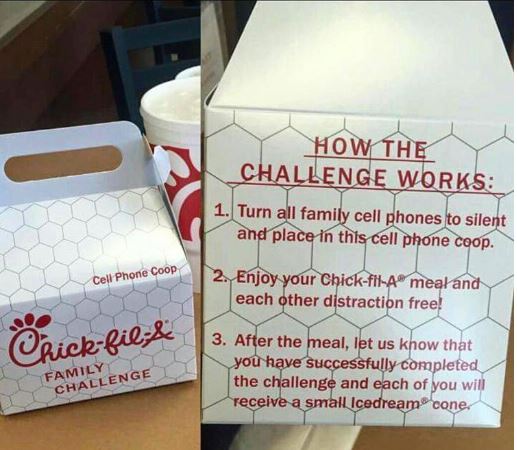In this morning’s newspaper I read a very interesting article about Chick-fil-A. In short, the wildly popular restaurant has started a campaign to discourage folks from using their phones while dining in their eateries.
Many Chick-fil-A locations now have paper boxes for groups to place their phones in when they sit down at a booth. Marketed as “cell phone coops,” the boxes are supposed to help provide a peaceful dining experience. The thought is that families dining at Chick-fil-A restaurants will engage with each other as opposed to engaging with their devices.
Obviously it is a nice and wholesome idea to begin with. But customers who crave a digital distraction free meal will be delighted to know that there is more. If a group surrenders their phones into the coop and manages not to grab for them during their meal, a sweet incentive is given. Totally on their honor, successful families/friends/teams/etc. can go up to the front counter and say they passed the challenge. Everyone in the group is then rewarded with a free ice cream cone. Yes, it is a great concept.

This is what the cell phone coop looks like.
However, as a marketer, I am not the biggest fan.
Most companies are tickled to death when customers show themselves using or consuming a product. For fast food restaurants, this equivalent is people taking any sort of media of their food. In this day and age, it is almost second nature for younger generations to take a photo of their lunch, add an image to their Snapchat story with the restaurant’s geofilter, or record a Vine that shows them eating their sandwich in six seconds. Not only is this FREE marketing, but in my opinion, it is also the best marketing! There is nothing more valuable than user generated content and social media testimonials. The booths and tables of fast food restaurants across the nation are where a company’s brand strength is really established.
With Chick-fil-A this sentiment is magnified even more. I don’t know of any other fast food joint that has such a passionate, cult-like customer base. When I look at my social media channels no other comparable restaurant comes close to Chick-fil-A in regards to name and hashtag mentions. I constantly see people who visit the place on a weekly basis tweet about how they can’t live without it. On top of that, I also see the social media reaction from people who must live without it. I have many friends residing in Washington and Montana who freak out by posting snaps, Instagram images, and Facebook photos whenever they travel out of state to a location where they get to eat at a Chick-fil-A restaurant.
This enthusiasm that is expressed on social media is marketing gold. It is brand awareness that money can’t buy. It is the type of exposure that marketers dream of. Why would any company want to sabotage such a prime outlet by asking customers to go device free at the social hub known as the restaurant booth?
Well, to put it simply, it is because your company happens to be Chick-fil-A.
When I read the article I actually wasn’t that surprised with the seemingly blatant slap in the face to marketing potential. You see, Chick-fil-A is just different. This fast food giant prides itself on doing things their way. It doesn’t matter if that means closing on Sundays, taking positions on social/religious issues, or encouraging customers to put their phones down while eating. Whatever they seem to do, it just works.
So while I cringe at Chick-fil-A giving customers an incentive to literally not spread the company name at dinner, I also respect it. Going against Marketing 101 best practices is a hallmark of this unique chain and last time I checked they seem to be doing pretty well. Don’t Blink.
